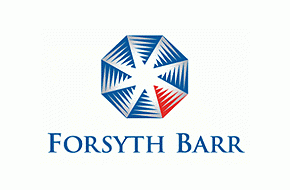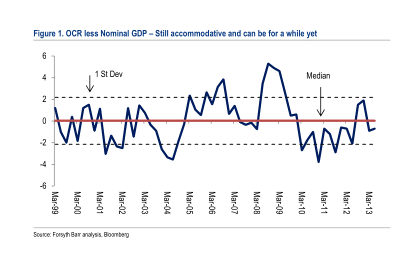
Content supplied by Forsyth Barr
The following is a summary of the key events impacting fixed income markets over the past week.
The Reserve Bank of New Zealand went head to head with the US Federal Reserve last week, delivering their respective monetary policy statements on Thursday morning (NZ Time). Both commentaries were ‘as expected’ providing little fresh direction to the markets.
RBNZ stick to the status quo
The Official Cash Rate (OCR) review was largely uneventful with little in the way of market reaction. The RBNZ did however state that the high NZD may provide it with some flexibility around the timing of possible rises in the OCR. This has led most of the markets to shift out their expectations from March 2014 to April 2014 for the first hike in the OCR.
While raising the OCR with an NZD as strong as this, or in a weak USD environment, may be fraught with danger, inflationary pressures are building (expected to head towards the mid-point of the RBNZ band at 2%) and economic growth is estimated to be around 3%. So in summary the strong NZD may be helping to keep interest rates low but it will also be impacting on the export sector of NZ’s economy.
The numbers from the week
Interest rates across all forms were higher over the course of the week with US 10 year treasury yields rising +10bp to 2.62% and New Zealand swap rates rising ~+4bp to 10bp across the curve. Unemployment rates, both local and in the US will be the main economic data analysed along with the Reserve Bank of Australia’s monthly monetary policy statement on.
The Fed delivers at last
The US Federal Reserve finally stuck to the script and delivered an expected monetary policy statement last week. Overall the Fed’s statement was less dovish than expected but the Fed reiterated its commitment to maintain its stimulus programme of US$85bn per month. The Fed, while encouraged by improving economic data, will delay tapering until economic data strengthens in a meaningful way.
The latest forecasts from the ‘experts’ (according to Bloomberg) is for tapering to begin in March 2014, reducing from US$85bn to US$70bn before rapidly concluding by October 2014.
More capital please – Assumptions may prove wrong
In a move which will benefit bank bondholders, the ‘big four’ Australian banks may have to hold additional capital from 2016. The Australian Prudential Regulation Authority (APRA) will impose a charge on systemically important banks from 2016. Banks had been working on the assumption that it would be in the order of a 0.5% buffer, however it is now thought that it is likely to be around 1% to 1.5% buffer on top of the existing 7%.
Increasing capital fails to dampen profits
Over the last week we have had three of the big four Australian banks report their full year earnings with snippets regarding the New Zealand part of their business. For the year ended 30 September ANZ, BNZ and WBC reported a combined NZ$2.9bn in profits. Deposits growth still appears to be strong with double digit growth common while lending growth, although improving, remains ~3% to 4%.
Is the high NZD helping or hindering?
The Reserve Bank of New Zealand released its Official Cash Rate (OCR) review last week and it contained everything that most were expecting from comments on the NZD, inflation, growth, to loan-to-value restrictions.
What was a touch different from previous releases was that the RBNZ pointed out that the strength of the NZD may provide the central bank with some flexibility in respect to the timing of possible OCR hikes and the overall size of the hikes.
“The exchange rate remains high and is a headwind to the traded goods sector. Sustained strength in the exchange rate that leads to lower inflationary pressure would provide the Bank with greater flexibility as to the timing and magnitude of future increases in the OCR. Due mainly to the continued quantitative easing in the US, the NZD’s strength is offsetting the inflationary pressures arising from house construction.
The RBNZ also provided its assessment of economic growth with an estimated GDP growth of 3%, which is consistent with its September Monetary Policy Statement and forecast for 2014.
“The New Zealand economy is estimated to have grown by more than 3 percent in the year to September. Household spending is rising, and reconstruction in Canterbury is being reinforced by a broader rise in construction in Auckland and across the country more generally. This will support economic activity and start to ease the housing shortage.
In the chart below we can see the RBNZ’s monetary policy is still slightly accommodative, but with continued economic growth the OCR would need to rise. At present the forecasts of a rise sometime mid 2014 appear to be warranted. As a result of the implementation and expected result from the loan-to-value restrictions and on-going US money printing, the market forecasts have been pushed out from March 2014 to April 2014 for the first rise in the OCR.

Corporate / Credit news
APN News & Media (APN) announced it was waiting for clearance from the Commerce Commission to sell its New Zealand Magazines business to Bauer Media Group.
Auckland Council had its AA (stable outlook) credit rating affirmed by S&P. S&P highlighted the Council’s very positive financial management amongst other features. A negative that constrains the rating is the growing debt burden of the Council.
NAB reported its full year earnings stating that BNZ’s cash earnings for the year ended 30 September 2013 of NZ$788m rose 6.3% versus the pcp and net interest margins remained stable at 2.36%.
Heartland New Zealand (HNZ) had its credit rating outlook revised from “Stable“ to “Developing” by S&P. This new outlook reflects the prospect that HNZ’s rating could be raised or lowered within the next two years depending on various scenarios.
NZ Post announced it would reduce its work force by up to 2000 staff over the next five years. Chairman Michael Cullen confirmed that NZ Post had held discussions with the NZ Superannuation Fund about investing directly into Kiwibank as the bank needs additional capital and a partial float would be seen as damaging the brand.
Rabobank has agreed to pay a €774m settlement to various authorities in relation to the Libor fixing scandal. Rabobank had provisioned for the fine in its June accounts however admitted that it did not fully appreciate the risks associated with the Libor and Euribor submission process. The Chairman of the executive board, Piet Moerland, resigned as a consequence.
Toyota Finance New Zealand raised NZ$75m across a NZ$50m fixed rate line and NZ$25m floating rate note priced at 85bp over the 90 day bank bill rate. The coupon on the fixed rate bond is 5.25% with both bonds maturing in April 2019.
The University of Canterbury received a NZ$260m capital injection from the New Zealand government. The government will provide an immediate NZ$10m investment to support detailed planning for major capital projects along with NZ$250m investment in new and upgraded learning and research facilities in engineering and science.
Westpac (Australia) reported its FY13 results where its NPAT rose +14% to A$6.82bn. The New Zealand part of the business performing well with house lending +3% and deposit growth +4%. WBC reduced its exposure to loans with an LVR of greater than 80%, however it remains above 20% at 20.9%.
---------------------------------------------------------------------------------------------------
Disclosures and Disclaimers:
Disclosure: The comments in this publication are for general information purposes only. This publication is not intended to constitute investment advice under the Securities Markets Act 1988. If you wish to receive specific investment advice, please contact your Investment Advisor. Forsyth Barr Limited and its related companies (and their respective officers, agents and employees) may own or have an interest in securities or other products referred to in this publication, and may be directors or officers of, or provide investment banking services to, the issuer of those securities or products, and may receive fees for acting in any such capacity in relation to that issuer. Further, they may buy or sell securities as principal or agent, and as such may undertake transactions that are not consistent with any recommendations contained in this publication. Forsyth Barr Limited and its related companies (and their respective officers, agents and employees) confirms no inducement has been accepted from the researched/recommended entity, whether pecuniary or otherwise, in connection with making any recommendation contained in this publication or on our website.
Analyst Disclosure Statement: In preparing this publication the analyst(s) may or may not have a threshold interest in the securities mentioned in this publication. A threshold interest is defined as being a holder of more than $50,000 or 1% of the securities on issue, whichever is the lesser. In preparing this publication non-financial assistance may have been provided by the entity being researched. A disclosure statement is available on request and is free of charge.
Disclaimer: This publication has been prepared in good faith based on information obtained from sources believed to be reliable and accurate. However, that information has not been independently verified or investigated by Forsyth Barr Limited. Accordingly, Forsyth Barr Limited: (a) does not make any representation or warranty (express or implied) that the information is accurate, complete or current; and (b) excludes and disclaims (to the maximum extent permitted by law) any liability for any loss which may be incurred by any person as a result of that information being inaccurate or incomplete in any way or for any reason. The information, analyses and recommendations contained in this publication are confidential to the intended recipients and are statements of opinion only. They have been prepared for general information purposes and whilst every care has been taken in their preparation, no warranty or representation is given (express or implied) as to their accuracy or completeness. Nothing in this publication should be construed as a solicitation to buy or sell any security or other product, or to engage in or refrain from doing so or engaging in any other transaction. This publication should not be used as a substitute for specific advice. This publication is intended to provide general securities advice only, and has been prepared without taking account of your objectives, financial situation or needs, and therefore prior to acting on any information, analysis or recommendation contained in this publication, you should seek advice from your usual Investment Advisor. Forsyth Barr Limited and its related companies (and their respective officers, agents and employees) will not be liable for any loss whatsoever suffered by any person relying upon any such information, analysis or recommendation. This publication is not intended to be distributed or made available to any person in any jurisdiction where doing so would constitute a breach of any applicable laws or regulations.
We welcome your comments below. If you are not already registered, please register to comment
Remember we welcome robust, respectful and insightful debate. We don't welcome abusive or defamatory comments and will de-register those repeatedly making such comments. Our current comment policy is here.